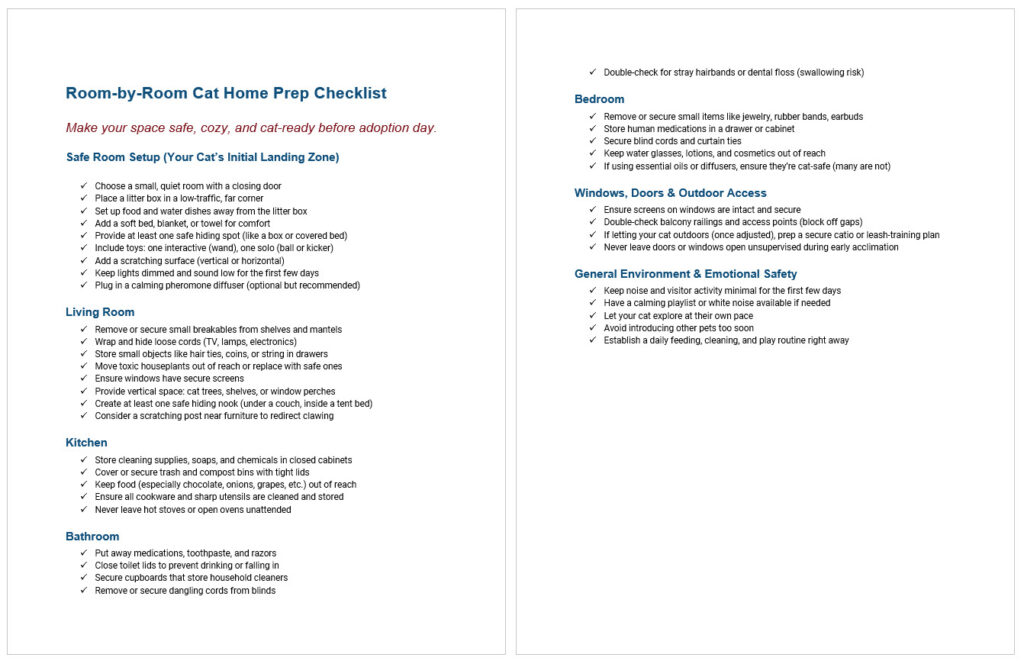Home Setup Guide & Checklist for Bringing Home New Cats
Creating a Safe, Stress-Free Space Before Your Cat Arrives
View, Download or Print the Free Home Setup Guide and Checklist (PDF)
At Kitty Crew LA, we love cats and want all of our feline friends to have the best chance at finding and settling in to their fur-ever homes quickly, smoothly and with as little stress as possible.
We created this free to download and print guide and checklist to help you prepare your home room-by-room to ensure your new feline family member has the easiest transition.
In This "Home Prep Guide and Checklist"
Home Setup Guide for New Cats
Creating a Safe, Stress-Free Space Before Your Cat Arrives
Bringing home a new cat isn’t just a matter of opening your door and letting them roam. It’s about building a space where they can feel secure, decompress, and gradually learn to trust you and your environment. Whether you’re welcoming a kitten, a shy rescue, or a confident adult cat, your setup will dramatically influence their behavior and well-being.
This guide walks you through exactly how to prepare your home – thoughtfully and room by room – to give your new feline family member the very best start.
Start with a Safe Room
Your cat’s introduction to your home shouldn’t be a grand tour – it should be a gentle hello. The best way to achieve that is by designating a “safe room” – a small, enclosed space like a spare bedroom, office, or bathroom where your cat can acclimate slowly.
This space should include the basics: a litter box in a quiet corner, food and water bowls placed well away from the litter, and a cozy place to hide (a cardboard box with a soft blanket works wonders). Add a scratching post, a few toys, and some bedding that carries your scent. Keep lighting low and sound minimal for the first day or two.
Let this be their sanctuary. They don’t need the run of the house on day one. In fact, the more space they have too soon, the more overwhelmed they’re likely to feel.
Litter Box Placement – Quiet, Clean, Accessible
Where you place the litter box matters. Think of it like placing a bathroom for a guest – it should be somewhere private, not right next to their food, and not in a high-traffic area like a hallway or next to a washer and dryer. If your cat has limited mobility or is older, make sure it’s easy to reach.
Stick with unscented clumping litter at first and avoid strong cleaners that may deter use. A daily scoop and weekly change go a long way toward keeping your cat comfortable and preventing accidents.
In multi-cat homes or large spaces, plan for more than one litter box. A good rule of thumb is one box per cat, plus one extra.
Pet-Proof Like You Mean It
Cats are master explorers – and their curiosity can get them into trouble if you haven’t prepared. Before your new cat arrives, do a sweep of your home and remove or secure common hazards.
Certain houseplants like lilies, aloe, and pothos can be toxic. Keep them out of reach or remove them entirely. Blinds with dangling cords should be tied up, and small items like rubber bands, string, and hair ties should be kept in drawers. Medications, household cleaners, and cosmetics should be stored away securely. Trash cans especially those in kitchens or bathrooms – should have lids.
And don’t forget about windows and balconies. Even if you think your cat would never jump, install sturdy screens or barriers just in case. Their instincts can kick in fast – and unexpectedly.
First Day Vibes – Calm, Predictable, Low-Stress
Your cat’s first few hours in their new home set the tone for everything that follows. When you bring them in, skip the fanfare. No excited greetings, no tours, no meet-and-greets with every member of the household.
Take them directly to the safe room. Open the carrier and let them come out on their own. You might sit quietly in the room, read a book, or just hang out on your phone nearby – the goal is to be present without overwhelming them.
Offer food, a treat, or a toy, but don’t push. Some cats will explore right away; others may stay hidden for a day or more. That’s perfectly normal. Let them set the pace. Your patience in those first moments will go a long way in building trust.
Final Thoughts
Welcoming a cat isn’t about giving them the run of your home – it’s about giving them a reason to trust you. That starts with creating an environment that feels safe, predictable, and respectful of their instincts.
Think like a cat: quiet corners, vertical spaces, clean litter, and no surprises. With this guide (and a bit of empathy), you’re not just prepping a house – you’re creating a forever home.
Room-by-Room Cat Home Prep Checklist
Make your space safe, cozy, and cat-ready before adoption day.
Safe Room Setup (Your Cat’s Initial Landing Zone)
- Choose a small, quiet room with a closing door
- Place a litter box in a low-traffic, far corner
- Set up food and water dishes away from the litter box
- Add a soft bed, blanket, or towel for comfort
- Provide at least one safe hiding spot (like a box or covered bed)
- Include toys: one interactive (wand), one solo (ball or kicker)
- Add a scratching surface (vertical or horizontal)
- Keep lights dimmed and sound low for the first few days
- Plug in a calming pheromone diffuser (optional but recommended)
Living Room
- Remove or secure small breakables from shelves and mantels
- Wrap and hide loose cords (TV, lamps, electronics)
- Store small objects like hair ties, coins, or string in drawers
- Move toxic houseplants out of reach or replace with safe ones
- Ensure windows have secure screens
- Provide vertical space: cat trees, shelves, or window perches
- Create at least one safe hiding nook (under a couch, inside a tent bed)
- Consider a scratching post near furniture to redirect clawing
Kitchen
- Store cleaning supplies, soaps, and chemicals in closed cabinets
- Cover or secure trash and compost bins with tight lids
- Keep food (especially chocolate, onions, grapes, etc.) out of reach
- Ensure all cookware and sharp utensils are cleaned and stored
- Never leave hot stoves or open ovens unattended
Bathroom
- Put away medications, toothpaste, and razors
- Close toilet lids to prevent drinking or falling in
- Secure cupboards that store household cleaners
- Remove or secure dangling cords from blinds
- Double-check for stray hairbands or dental floss (swallowing risk)
Bedroom
- Remove or secure small items like jewelry, rubber bands, earbuds
- Store human medications in a drawer or cabinet
- Secure blind cords and curtain ties
- Keep water glasses, lotions, and cosmetics out of reach
- If using essential oils or diffusers, ensure they’re cat-safe (many are not)
Windows, Doors & Outdoor Access
- Ensure screens on windows are intact and secure
- Double-check balcony railings and access points (block off gaps)
- If letting your cat outdoors (once adjusted), prep a secure catio or leash-training plan
- Never leave doors or windows open unsupervised during early acclimation
General Environment & Emotional Safety
- Keep noise and visitor activity minimal for the first few days
- Have a calming playlist or white noise available if needed
- Let your cat explore at their own pace
- Avoid introducing other pets too soon
- Establish a daily feeding, cleaning, and play routine right away
This free home setup guide and checklist for new cats is provided free of charge by KittyCrewLA.org.


